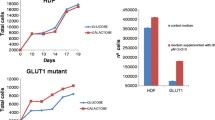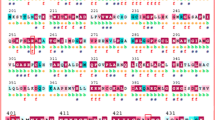Abstract
Glucose transporter type 1 deficiency syndrome (GLUT-1DS) is characterized by alterations in glucose translocation through the blood–brain barrier (BBB) due to mutation involving the GLUT-1 transporter. The fundamental therapy is ketogenic diet (KD) that provide an alternative energetic substrate — ketone bodies that across the BBB via MCT-1 — for the brain. Symptoms are various and include intractable seizure, acquired microcephalia, abnormal ocular movement, movement disorder, and neurodevelopment delay secondary to an energetic crisis for persistent neuroglycopenia. KD is extremely effective in controlling epileptic seizures and has a positive impact on movement disorders and cognitive impairment. Cases of KD resistance are rare, and only a few of them are reported in the literature, all regarding seizure. Our study describes a peculiar case of GLUT-1DS due to a new deletion involving the first codon of SLC2A1 gene determining a loss of function with a resistance to KD admitted to hospital due to intractable episodes of dystonia. This patient presented a worsening of symptomatology at higher ketonemia values but without hyperketosis and showed a complete resolution of symptomatology while maintaining low ketonemia values. Our study proposes an in-silico genomic and proteomic analysis aimed at explaining the atypical response to KD exhibited by our patient. In this way, we propose a new clinical and research approach based on precision medicine and molecular modelling to be applied to patients with GLUT-1DS resistant to first-line treatment with ketogenic diet by in silico study of genetic and altered protein product.




Similar content being viewed by others
Data availability
All data generated or analysed during this study are included in the published article.
References
De Vivo DC, Trifiletti RR, Jacobson RI, Ronen GM, Behmand RA, Harik SI (1991) Defective glucose transport across the blood-brain barrier as a cause of persistent hypoglycorrhachia, seizures, and developmental delay. N Engl J Med 325:703–709. https://doi.org/10.1056/NEJM199109053251006
Klepper J, Akman C, Armeno M, Auvin S, Cervenka M, Cross HJ et al (2020) Glut1 Deficiency Syndrome (Glut1DS): State of the art in 2020 and recommendations of the international Glut1DS study group. Epilepsia Open 5:354–365. https://doi.org/10.1002/epi4.12414
Wang D, Pascual JM, De Vivo D (2018) Glucose Transporter Type 1 Deficiency Syndrome. In: Adam MP, Feldman J, Mirzaa GM, Pagon RA, Wallace SE, Bean LJH, Gripp KW, Amemiya A (eds) GeneReviews® [Internet]. Seattle (WA), University of Washington, Seattle, pp 1993–2024
Cano A, Ticus I, Chabrol B (2008) Glucose transporter type 1 (GLUT-1) deficiency. Rev Neurol (Paris) 164:896–901. https://doi.org/10.1016/j.neurol.2008.02.033
Brockmann K (2009) The expanding phenotype of GLUT1-deficiency syndrome. Brain Dev 31:545–552. https://doi.org/10.1016/j.braindev.2009.02.008
Varesio C, Pasca L, Parravicini S, Zanaboni MP, Ballante E, Masnada S et al (2019) Quality of life in chronic ketogenic diet treatment: the GLUT1DS population perspective. Nutrients 11:1650. https://doi.org/10.3390/nu11071650
Bekker YAC, Lambrechts DA, Verhoeven JS, van Boxtel J, Troost C, Kamsteeg E-J et al (2019) Failure of ketogenic diet therapy in GLUT1 deficiency syndrome. Eur J Paediatr Neurol 23:404–409. https://doi.org/10.1016/j.ejpn.2019.02.012
Comella CL, Leurgans S, Wuu J, Stebbins GT, Chmura T, The Dystonia Study Group (2003) Rating scales for dystonia: a multicenter assessment. Mov Disord 18:303–12. https://doi.org/10.1002/mds.10377
Sun S (1993) Reduced representation model of protein structure prediction: statistical potential and genetic algorithms. Protein Sci 2:762–785. https://doi.org/10.1002/pro.5560020508
Melo F, Sánchez R, Sali A (2002) Statistical potentials for fold assessment. Protein Sci 11:430–448. https://doi.org/10.1002/pro.110430
Deng D, Xu C, Sun P, Wu J, Yan C, Hu M et al (2014) Crystal structure of the human glucose transporter GLUT1. Nature 510:121–125. https://doi.org/10.1038/nature13306
Klepper J, Leiendecker B (2007) GLUT1 deficiency syndrome—2007 update. Dev Med Child Neurol 49:707–716. https://doi.org/10.1111/j.1469-8749.2007.00707.x
Mueckler M, Caruso C, Baldwin SA, Panico M, Blench I, Morris HR et al (1985) Sequence and structure of a human glucose transporter. Science 229:941–945. https://doi.org/10.1126/science.3839598
Larsen J, Johannesen KM, Ek J, Tang S, Marini C, Blichfeldt S et al (2015) The role of SLC2A1 mutations in myoclonic astatic epilepsy and absence epilepsy, and the estimated frequency of GLUT1 deficiency syndrome. Epilepsia 56:e203-208. https://doi.org/10.1111/epi.13222
Felmlee MA, Jones RS, Rodriguez-Cruz V, Follman KE, Morris ME (2020) Monocarboxylate transporters (SLC16): function, regulation, and role in health and disease. Pharmacol Rev 72:466–485. https://doi.org/10.1124/pr.119.018762
Cappuccio G, Pinelli M, Alagia M, Donti T, Day-Salvatore D-L, Veggiotti P et al (2017) Biochemical phenotyping unravels novel metabolic abnormalities and potential biomarkers associated with treatment of GLUT1 deficiency with ketogenic diet. PLoS One 12:e0184022. https://doi.org/10.1371/journal.pone.0184022
Leen WG, Klepper J, Verbeek MM, Leferink M, Hofste T, van Engelen BG et al (2010) Glucose transporter-1 deficiency syndrome: the expanding clinical and genetic spectrum of a treatable disorder. Brain 133:655–670. https://doi.org/10.1093/brain/awp336
Leary LD, Wang D, Nordli DR, Engelstad K, De Vivo DC (2003) Seizure characterization and electroencephalographic features in Glut-1 deficiency syndrome. Epilepsia 44:701–707. https://doi.org/10.1046/j.1528-1157.2003.05302.x
Klepper J, Scheffer H, Leiendecker B, Gertsen E, Binder S, Leferink M et al (2005) Seizure control and acceptance of the ketogenic diet in GLUT1 deficiency syndrome: a 2- to 5-year follow-up of 15 children enrolled prospectively. Neuropediatrics 36:302–308. https://doi.org/10.1055/s-2005-872843
Klepper J (2012) GLUT1 deficiency syndrome in clinical practice. Epilepsy Res 100:272–277. https://doi.org/10.1016/j.eplepsyres.2011.02.007
Alter AS, Engelstad K, Hinton VJ, Montes J, Pearson TS, Akman CI et al (2015) Long-term clinical course of Glut1 deficiency syndrome. J Child Neurol 30:160–169. https://doi.org/10.1177/0883073814531822
Hao J, Kelly DI, Su J, Pascual JM (2017) Clinical aspects of glucose transporter type 1 deficiency: information from a global registry. JAMA Neurol 74:727–732. https://doi.org/10.1001/jamaneurol.2017.0298
Logel SN, Connor EL, Hsu DA, Fenske RJ, Paloian NJ, De Vivo DC (2021) Exploring diazoxide and continuous glucose monitoring as treatment for Glut1 deficiency syndrome. Ann Clin Transl Neurol 8:2205–2209. https://doi.org/10.1002/acn3.51462
Tchapyjnikov D, Mikati MA (2018) Acetazolamide-responsive episodic ataxia without baseline deficits or seizures secondary to GLUT1 deficiency: a case report and review of the literature. Neurologist 23:17–18. https://doi.org/10.1097/NRL.0000000000000168
Ordoñez R, Zhang W, Ellis G, Zhu Y, Ashe HJ, Ribeiro-Dos-Santos AM et al (2023) Genomic context sensitizes regulatory elements to genetic disruption. bioRxiv [Preprint]. https://doi.org/10.1101/2023.07.02.547201
Vulturar R, Chiș A, Pintilie S, Farcaș IM, Botezatu A, Login CC et al (2022) One molecule for mental nourishment and more: glucose transporter type 1—biology and deficiency syndrome. Biomedicines 10:1249. https://doi.org/10.3390/biomedicines10061249
Chang P, Augustin K, Boddum K, Williams S, Sun M, Terschak JA et al (2016) Seizure control by decanoic acid through direct AMPA receptor inhibition. Brain 139:431–443. https://doi.org/10.1093/brain/awv325
Sakai H, Fujii Y, Kuwayama N, Kawaji K, Gotoh Y, Kishi Y (2019) Plag1 regulates neuronal gene expression and neuronal differentiation of neocortical neural progenitor cells. Genes Cells 24:650–666. https://doi.org/10.1111/gtc.12718
Li J, O’Leary EI, Tanner GR (2017) The ketogenic diet metabolite beta-hydroxybutyrate (β-HB) reduces incidence of seizure-like activity (SLA) in a Katp- and GABAb-dependent manner in a whole-animal Drosophila melanogaster model. Epilepsy Res 133:6–9. https://doi.org/10.1016/j.eplepsyres.2017.04.003
Lopes EF, Roberts BM, Siddorn RE, Clements MA, Cragg SJ (2019) Inhibition of nigrostriatal dopamine release by striatal GABAA and GABAB receptors. J Neurosci 39:1058–1065. https://doi.org/10.1523/JNEUROSCI.2028-18.2018
Avshalumov MV, Rice ME (2003) Activation of ATP-sensitive K+ (K(ATP)) channels by H2O2 underlies glutamate-dependent inhibition of striatal dopamine release. Proc Natl Acad Sci U S A 100:11729–11734. https://doi.org/10.1073/pnas.1834314100
Ferré S, Torvinen M, Antoniou K, Irenius E, Civelli O, Arenas E et al (1998) Adenosine A1 receptor-mediated modulation of dopamine D1 receptors in stably cotransfected fibroblast cells. J Biol Chem 273:4718–4724. https://doi.org/10.1074/jbc.273.8.4718
Cortés A, Casadó-Anguera V, Moreno E, Casadó V (2019) The heterotetrameric structure of the adenosine A1-dopamine D1 receptor complex: Pharmacological implication for restless legs syndrome. Adv Pharmacol 84:37–78. https://doi.org/10.1016/bs.apha.2019.01.001
Striano P, Auvin S, Collins A, Horvath R, Scheffer IE, Tzadok M et al (2022) A randomized, double-blind trial of triheptanoin for drug-resistant epilepsy in glucose transporter 1 deficiency syndrome. Epilepsia 63:1748–1760. https://doi.org/10.1111/epi.17263
Varesio C, De Giorgis V, Veggiotti P, Nardocci N, Granata T, Ragona F et al (2023) GLUT1-DS Italian registry: past, present, and future: a useful tool for rare disorders. Orphanet J Rare Dis 18:63. https://doi.org/10.1186/s13023-023-02628-2
Author information
Authors and Affiliations
Corresponding author
Ethics declarations
Ethics approval and consent to participate
The research was conducted ethically in accordance with the World Medical Association Declaration of Helsinki and approved by ethics committee of the University of Catania, Italy (Ethical Committee Catania 1 Clinical Registration n. 180/2023/PO). Written informed consent was obtained from the patient for publication of this case report and any accompanying images. A copy of the written consent is available for review by the Editor-in-Chief of this journal.
Consent for publication
Written informed consent was obtained from the patient’s legal guardian for publication of this case report and any accompanying images. A copy of the written consent is available for review by the Editor-in-Chief of this journal.
Competing interests
The authors declare no competing interests.
Additional information
Publisher's Note
Springer Nature remains neutral with regard to jurisdictional claims in published maps and institutional affiliations.
Supplementary Information
Below is the link to the electronic supplementary material.
Rights and permissions
Springer Nature or its licensor (e.g. a society or other partner) holds exclusive rights to this article under a publishing agreement with the author(s) or other rightsholder(s); author self-archiving of the accepted manuscript version of this article is solely governed by the terms of such publishing agreement and applicable law.
About this article
Cite this article
Falsaperla, R., Sortino, V., Vitaliti, G. et al. GLUT-1DS resistant to ketogenic diet: from clinical feature to in silico analysis. An exemplificative case report with a literature review. Neurogenetics (2024). https://doi.org/10.1007/s10048-023-00742-8
Received:
Accepted:
Published:
DOI: https://doi.org/10.1007/s10048-023-00742-8




